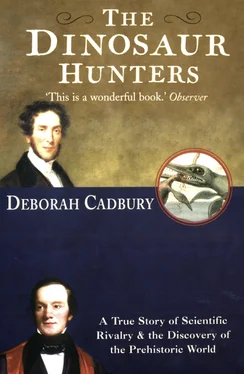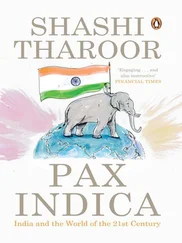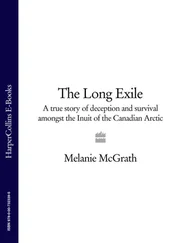Buckland told the Royal Society that the hyenas thrived in the ‘Ante-diluvian period, immediately preceding the Deluge’, and speculated that the extinct species in the cave were destroyed during the biblical Flood. These conclusions were based on the supposition that there were no human records of the species living in Europe since the Flood. As the bones were so well preserved in mud and silt he maintained the animals had been destroyed suddenly, and from the quantity of stalagmite in the cave above the mud he estimated that the inundation occurred six thousand years ago. In 1823, Buckland published a full-scale treatise, the ‘Reliquiae Diluvianae, or Relics of the Deluge’, in which he tried to fit this cave study and his earlier work on gravels with Cuvier’s most recent ‘catastrophe’.
Cuvier’s studies in the Paris basin had suggested that during each local catastrophe the land and the sea had changed places; this was reflected in alternating layers of marine and land strata. Buckland maintained that since the Yorkshire cave was inhabited by hyenas before the catastrophe that destroyed them, the area was land both before and after the Flood. The Flood, he reasoned, had been a transitory event during which the land remained in the same position. This lent weight to his view that any Flood should be viewed as a surge or tidal wave rather than a prolonged event. He also tried to show that the Flood had covered the whole globe. The fossils retrieved from the caves were identical to fossils found in loam and gravel deposits all over Europe, and so Buckland speculated that the same catastrophic event had destroyed the animals in the cave and swept the gravels to their positions. The gravel deposits were found in similar circumstances all over Europe, including hill sites, ‘to which no rivers could ever have drifted them’.
Although Reliquiae Diluvianae was immensely popular and sold out almost immediately, it unleashed a storm of comments from literalist theologians who believed in sticking to the letter of the Bible and disliked any conclusion that appeared to reduce the power of the Deluge. Rather than the caves being hyena dens, argued the Reverend George Young, a minister from Yorkshire, the awesome violence of the Flood had torn animals apart, limb from limb, forcing the confused debris of many of them into fissures in rocks and caves. The fractures and ‘bite-marks’ were not due to their having been eaten, but rather, testimony to the ‘wild confusion’ of the torrent in which the creatures were tossed and mangled. Others too, disputed that tropical animals had once lived in England. Tropical beasts were found in Yorkshire because the mighty currents had swept them thousands of miles. ‘Can we conclude with geologists that England must once have been inhabited by tropical animals merely because their remains are now found there, in a scattered and broken state?’ protested the theologian George Fairholme. ‘Had this not been the hypothesis of some of our ablest geologists it would have been termed the result of the most inconsiderate ignorance!’
As a backlash developed in response to Buckland’s interpretation of the Flood, other theological scholars challenged the idea that the Flood affected only the surface of the globe. In Moses’ account, ‘all the fountains of the deep’ were opened and the earth’s crust was totally destroyed by a mighty, raging torrent. According to Buckland, the Flood was a rather more modest affair, merely confined to shifting the superficial gravels. It wasn’t long before literalists objected to Buckland’s fundamental premise that geological epochs of immense duration had occurred before the Flood.
Layers of rock thousands of feet thick were demolished during the Deluge, according to the biblical scholar George Cumberland. ‘The fountains of waters contained in the great depths of the earth were broken up,’ he said. ‘Universal subsidence must have taken place. The operation must have been pretty rapid and immense layers of strata must have formed, filled up with the debris of the broken surface.’ Far from strata forming almost imperceptibly over countless years, there was a ‘sudden production of a thick sequence of rock!’ he claimed. ‘Such a world as ours might very well come forth in all its finished beauty instantaneously.’ The Reverend Young even produced an estimate of the speed of formation of the earth’s crust: ‘Provided there are currents to supply the materials, strata can form at a rate of nine hundred feet in a month!’ he declared.
George Fairholme captured the sense of outrage at the insolent new science that dared to challenge biblical records: ‘It is not unknown what ungodly avidity is exhibited by infidel philosophers … to distort every fact of science into a sophism against the Scriptures of eternal truth. Of these open scoffers … we have no dread; for the Bible has nothing to lose by being tried, like gold in the hottest crucible,’ he preached. ‘The gates of Hell itself cannot prevail against the word of God.’
William Buckland, with his blustering self-confidence and tremendous enthusiasm for his ‘noble subterranean science’, tried, as usual, to steer a path through these obstacles. But even his colleagues at the Geological Society questioned some of his evidence. How could he assume that the Flood was global, when gravels were found only in northern latitudes? The more the Reverend Buckland struggled to fit the findings of geology with the Bible, the more anomalies seemed to arise. Was Noah’s Flood transient or prolonged, global or local? Did the waters destroy only superficial layers or the entire earth’s crust? Were animals made extinct in one biblical Flood, or in a series of Cuvierian ‘catastrophes’? Or even, as Lamarck proposed, were species not truly extinct at all, merely transmuted into other creatures?
With some justification, one Scottish minister, John Flemming, summed up the confusion in a paper in the Edinburgh New Philosophical Journal: ‘The Geological Deluge, as interpreted by Baron Cuvier and Professor Buckland, [is] inconsistent with the testimony of Moses and the Phenomena of Nature.’ In Oxford, Buckland’s dilemmas were immortalised in a popular satire, Facetiae Diluvianae, in which Buckland met the great prophet Noah and each added to the bewilderment of the other.
Caught up in the storm at the birth of the new science, it is hardly surprising that the beleaguered Professor Buckland failed to announce the improbable discovery of a forty-foot reptile. However, Georges Cuvier in Paris was getting impatient since he wished to incorporate the information on the Stonesfield reptile in the updated volumes of his Recherches sur les Ossemens Fossiles. In September 1820, his assistant Joseph Pentland wrote to Buckland from the Muséum National in Paris: ‘Will you send your Stonesfield reptile, or will you publish it yourself?’ Deeply immersed in controversy, Buckland hesitated. A year later, the Reverend Conybeare also referred to the giant carnivorous lizard of Stonesfield in his paper on the Ichthyosaurus, adding ‘it is hoped [that Buckland] may soon communicate the results of his observations to the public’. But he did not. Soon, Pentland wrote once more, urging Buckland to announce the details of his research. Yet again, Buckland did nothing.
Thus the enormous bones continued to lie in the Ashmolean Museum, carefully prepared and neatly displayed behind the glass cages, an unexplained curiosity. They had become almost invisible by long acceptance, for over a century part of the paraphernalia of the museum alongside the stuffed animals and other objects. For the time being, in Oxford, the question mark they posed over the nature of giant reptilian beasts that had once lived on land was carefully and assiduously not seen.
Читать дальше












